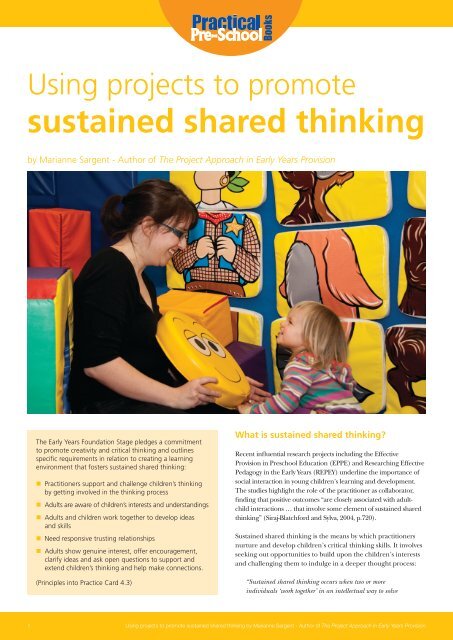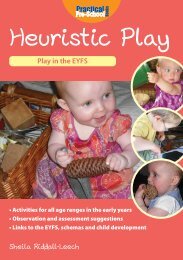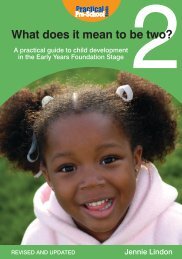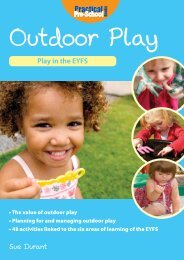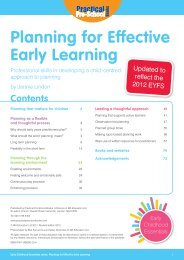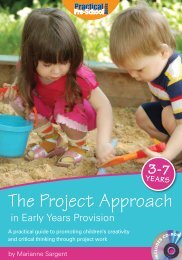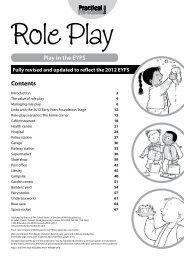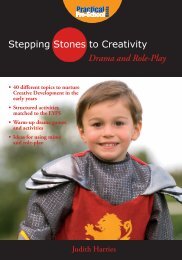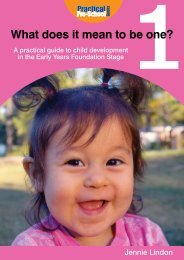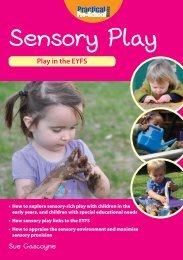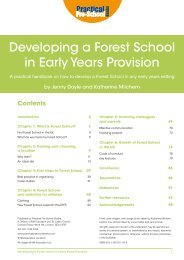Sustained Shared Thinking - Practical Pre-School Books
Sustained Shared Thinking - Practical Pre-School Books
Sustained Shared Thinking - Practical Pre-School Books
You also want an ePaper? Increase the reach of your titles
YUMPU automatically turns print PDFs into web optimized ePapers that Google loves.
<strong>Books</strong><br />
Using projects to promote<br />
sustained shared thinking<br />
by Marianne Sargent - Author of The Project Approach in Early Years Provision<br />
The Early Years Foundation Stage pledges a commitment<br />
to promote creativity and critical thinking and outlines<br />
specific requirements in relation to creating a learning<br />
environment that fosters sustained shared thinking:<br />
• Practitioners support and challenge children’s thinking<br />
by getting involved in the thinking process<br />
• Adults are aware of children’s interests and understandings<br />
• Adults and children work together to develop ideas<br />
and skills<br />
• Need responsive trusting relationships<br />
• Adults show genuine interest, offer encouragement,<br />
clarify ideas and ask open questions to support and<br />
extend children’s thinking and help make connections.<br />
(Principles into Practice Card 4.3)<br />
What is sustained shared thinking<br />
Recent influential research projects including the Effective<br />
Provision in <strong>Pre</strong>school Education (EPPE) and Researching Effective<br />
Pedagogy in the Early Years (REPEY) underline the importance of<br />
social interaction in young children’s learning and development.<br />
The studies highlight the role of the practitioner as collaborator,<br />
finding that positive outcomes “are closely associated with adultchild<br />
interactions … that involve some element of sustained shared<br />
thinking” (Siraj-Blatchford and Sylva, 2004, p.720).<br />
<strong>Sustained</strong> shared thinking is the means by which practitioners<br />
nurture and develop children’s critical thinking skills. It involves<br />
seeking out opportunities to build upon the children’s interests<br />
and challenging them to indulge in a deeper thought process:<br />
“<strong>Sustained</strong> shared thinking occurs when two or more<br />
individuals ‘work together’ in an intellectual way to solve<br />
1<br />
Using projects to promote sustained shared thinking by Marianne Sargent - Author of The Project Approach in Early Years Provision
a problem, clarify a concept, evaluate an activity, extend a<br />
narrative etc. Both parties must contribute to the thinking<br />
and it must develop and extend the understanding.”<br />
(Siraj-Blatchford et al, 2004, p.vi).<br />
<strong>Sustained</strong> shared thinking is a key approach in helping children<br />
to become life-long learners with transferable skills. Children<br />
who have the ability to enquire, consider, reflect, reason,<br />
predict, evaluate and suggest creative solutions, will be better<br />
equipped to succeed in a world where a job is no longer for life;<br />
careers are constantly evolving, demanding adaptability and a<br />
flexible approach. <strong>Thinking</strong> skills and sustained individual and<br />
creative thought must be introduced early in order for children<br />
to develop as learners and thrive in the future.<br />
What is the project approach<br />
Early years practitioners will be familiar with the use of topics<br />
and themes when planning in early education. It is common<br />
practice to choose a new topic each half term and plan subjectrelated<br />
activities around the theme of animals or seasons. The<br />
chosen topic is used to create commonality between curriculum<br />
areas and allows children to gain some basic knowledge about<br />
the focus subject matter.<br />
The project approach involves planning to exploit an area of<br />
interest – which may stem from a topic – and using it as a basis<br />
for in-depth enquiry or research. Areas of learning are not<br />
simply linked by a theme, they are integrated as a result of the<br />
investigative process. Knowledge and skills are not taught in<br />
isolation, but rather acquired and practised within a meaningful<br />
context that makes sense to the children. For example,<br />
practitioners may plan a farm topic that aims to inform children<br />
about the various animals and foods that are bred and cultivated<br />
on a farm. In addition to this, practitioners might plan a range<br />
of farm themed activities aimed at teaching children skills in<br />
mathematics and literacy. For example, counting eggs produced<br />
by chickens or reading farm themed stories. In contrast, a<br />
project stemming from a provoking farm visit might be planned<br />
in response to the children’s interest in tractors. The children<br />
may be given the opportunity to investigate a real tractor and<br />
see a farmer demonstrate how it moves and works. This could<br />
lead to any number of different activities that incidentally cover<br />
a number of areas of learning. For example, the children may<br />
choose to draw pictures of tractors and label the different parts;<br />
they might create models of tractors with moving parts; or they<br />
might experiment with using tractors to dig sand, transport the<br />
sand, and fill containers. This could lead to an investigation into<br />
the purpose and use of tractors in the sand pit.<br />
Projects stem from the interests of the children and are<br />
planned or developed in collaboration with them. This is in<br />
contrast to topics that might have initially been suggested by<br />
the children but are ultimately planned and developed by<br />
adults to meet predetermined curriculum objectives.<br />
A project is started with an initial provocation that triggers<br />
conversation and debate. A provocation could be:<br />
• An event, e.g. a visit to the dentist or a village fête;<br />
• A question such as “why do pine cones open and close”<br />
or “how does a bicycle work”;<br />
• A picture, e.g. a famous artwork or a photograph of a puppet<br />
misbehaving;<br />
• An object, e.g. a tractor wheel or a foreign fruit.<br />
After the children have had some time to explore this<br />
provocation or trigger, they are gathered together to share their<br />
experiences and think about what they would like to find out or<br />
do next. The children’s questions and ideas are recorded and<br />
practitioners meet together to discuss and use these suggestions<br />
as a basis for planning the project. Practitioners then set up<br />
various resources around the setting that will help facilitate<br />
the children’s explorations. The children might investigate<br />
individually, in groups, or as a class and practitioners work<br />
alongside them to help develop and extend their ideas.<br />
The book, The Project Approach in Early Years Provision, explains<br />
how to plan and carry out a project and provides several case<br />
studies as examples. These include, planting a fake cocoon<br />
in a reception classroom to build on the children’s interest<br />
in butterflies; hiding a popular puppet, prompting a missing<br />
person’s investigation; and an alternative idea for encouraging<br />
nursery children to investigate freezing and melting.<br />
In her recent review of the EYFS Dame Tickell (2011)<br />
underlines the importance of active learning, and in<br />
particular playing and exploring. She explains that children<br />
learn through active investigation and it is through such<br />
concrete learning experiences that children have the<br />
opportunity to develop creative and critical thinking skills.<br />
How do projects promote the use of<br />
thinking skills<br />
In order to learn critical thinking skills children need to be<br />
given the opportunity to immerse themselves in a deeper<br />
thought process with the help of skilled practitioners:<br />
“All of us have the ability to think creatively, but the extent to<br />
which we do will probably be highly dependent on the quality of<br />
our earliest experiences … With the right stimulus and support<br />
2<br />
Using projects to promote sustained shared thinking by Marianne Sargent - Author of The Project Approach in Early Years Provision
all children can learn to think in ways that enable them<br />
to solve problems, be inventive and make discoveries…”<br />
(Bayley and Broadbent, 2002, p.i).<br />
Project work promotes the use of creative and critical thinking<br />
skills in the following ways:<br />
Information processing skills<br />
Information-processing skills enable children to gather and<br />
use information.<br />
When first encountering a provocation, the children process<br />
what they are seeing and begin to analyse the information<br />
they gather through their explorations. As the project<br />
develops they may be required to classify information, look<br />
for connections and apply their newly gained knowledge to a<br />
variety of situations.<br />
Reasoning skills<br />
Reasoning skills enable children to use logic; make connections;<br />
give reasons for opinions and explain actions; and make<br />
informed judgements and decisions.<br />
Project work involves constant discussion and debate.<br />
Throughout a project the children are frequently asked to<br />
share their ideas and opinions with each other, as well as with<br />
practitioners. Practitioners use open questioning to encourage<br />
children to draw on their knowledge and experience and<br />
provide reasons and explanations.<br />
Enquiry skills<br />
Enquiry skills enable children to ask relevant questions; plan<br />
what to do; and speculate upon and predict outcomes.<br />
Although young children are naturally inquisitive they often<br />
have difficulty formulating questions in order to gather the<br />
information they require. Charlesworth (2005) suggests that<br />
children should be encouraged to ask questions in order<br />
to develop their enquiry skills, but that they first need to<br />
understand what questions are for and how they are formed.<br />
Projects provide plenty of opportunity for children to practice<br />
these skills.<br />
Creative thinking and problem solving skills<br />
Creative thinking and problem solving skills enable children<br />
to come up with ideas and suggestions and to use their<br />
imagination to think of creative solutions.<br />
The aim of project work is to find out more about something.<br />
Children are not judged on performance or whether they get it<br />
right or wrong. Without such pressures, the children are more<br />
likely to consider problems and look for possible solutions,<br />
which will eventually lead them to learn skills such as preempting<br />
likely obstacles and creatively planning around them.<br />
Evaluation skills<br />
Evaluation skills enable children to reflect, recall and evaluate<br />
information in order to formulate opinions.<br />
Throughout the life of a project the children are asked to pause<br />
and reflect. Practitioners share photographic observations and<br />
film footage of the children involved in their investigations,<br />
and encourage them to recall what they learned. At the end of<br />
a project the children are presented with a display or learning<br />
story so that they can further reflect upon the project as a whole.<br />
Fantasising and imagining skills<br />
These skills enable children to suspend their disbelief and<br />
think imaginatively.<br />
According to Rattigan (2008) young children need such<br />
opportunities in order to develop their lateral thinking skills<br />
and personal creativity. Clarke explains that creative thinking<br />
“enables the learner to look for alternatives, not always<br />
accepting the first answer” (2007, p.12). In order to help<br />
children achieve this higher level of cognition, they should be<br />
exposed to open-ended experiences and encouraged to offer<br />
ideas. Setting up an imaginative provocation that leads to an<br />
interesting project is an ideal way of encouraging children to<br />
indulge in a fantasy and use creative thought.<br />
The Project Approach in Early Years Provision provides a detailed<br />
example of how a project about a missing puppet was used to<br />
develop the creative and critical thinking skills of a class of<br />
reception children.<br />
How can practitioners help children to use<br />
these skills<br />
Projects provide an ideal arena for promoting thinking skills.<br />
Children are engaged in investigations that perpetuate their<br />
interests and absorb them in ongoing open-ended activities. This<br />
gives practitioners ample opportunity to become involved in the<br />
children’s thought processes by introducing lines of questioning<br />
and enquiry. However, providing the guidance the children<br />
need to develop their investigative and critical thinking skills<br />
is a difficult task. Rinaldi highlights the difficulties that early<br />
years practitioners face in terms of gauging when and how to<br />
intervene and scaffold children’s learning:<br />
“The challenge for the teacher is to be present without being intrusive,<br />
in order to best sustain cognitive and social dynamics while they<br />
are in progress. At times the adult must foster productive conflict by<br />
challenging the responses of one or several children. At other times,<br />
the adult must step in to revive a situation where children are losing<br />
interest because the cognitive map that is being constructed is either<br />
beyond or beneath the child’s present capabilities. The teacher always<br />
remains an attentive observer…” (Rinaldi, 1998, p.119).<br />
3<br />
Using projects to promote sustained shared thinking by Marianne Sargent - Author of The Project Approach in Early Years Provision
Helm and Katz (2001) explain that rather than give children<br />
information, practitioners should give them time and space<br />
to obtain it for themselves. Practitioners can help with this by<br />
facilitating discussion, encouraging children to talk together<br />
and ask questions of each other as well as adults. This involves<br />
asking open questions, a difficult skill that takes time and<br />
practice to develop. For examples of open questions, see the<br />
prompt card on an investigation area below. It can be made<br />
easier by including question ideas on planning and observation<br />
documents. It is also a good idea to display reminders around<br />
the learning environment that will serve as prompts for all<br />
practitioners. This can be done in the following ways:<br />
Display open questions both inside and outside<br />
These serve as prompts for practitioners who are seeking to<br />
develop a conversation with a child in order to help further<br />
their thinking. The questions are intended to act as inspiration<br />
for practitioners, who need only glance up for a moment to<br />
get an idea about what to ask next. They also serve as useful<br />
prompts for additional adults such as students, parents and<br />
support staff, who might be new to the setting.<br />
Create sustained shared thinking cards<br />
It is also helpful to display cards that promote sustained<br />
shared thinking in each area of provision within the setting.<br />
These cards have suggestions for open-ended questions and<br />
useful key words that can be introduced into conversation. In<br />
addition, the cards might highlight where such activities fit<br />
into the curriculum.<br />
Set up informative displays<br />
Informative displays set at the children’s eye level are also an<br />
effective way to prompt discussion. Such displays might feature<br />
posters or photographs with snippets of information and questions<br />
about the project theme. These displays can be used to provide<br />
information and stimulate conversation about a subject. Helm<br />
and Katz (2001) suggest also mounting children’s questions for<br />
investigation in the relevant areas of provision around the setting.<br />
Reflect with the children<br />
Display photographs of the children taken while they were<br />
involved in their investigations. These photographs can be<br />
captioned with questions or observation notes and quotations<br />
An example of a sustained shared thinking card for the investigation area<br />
4<br />
Using projects to promote sustained shared thinking by Marianne Sargent - Author of The Project Approach in Early Years Provision
taken from the children. Practitioners can use these to help<br />
the children talk about their investigations and reflect upon<br />
what they have been doing. In addition, children can be<br />
involved in setting up displays that show others what they<br />
have learned.<br />
Conclusion<br />
This mini-guide has briefly demonstrated how projects can be<br />
used to promote the development of children’s creative and<br />
critical thinking skills. Setting up imaginative provocations is not<br />
only interesting and exciting for practitioners, but also a fun way of<br />
motivating young children to use and develop the most important<br />
skills they will need for their futures as life-long learners.<br />
References<br />
The article is written by Marianne<br />
Sargent, author of The Project<br />
Approach in Early Years<br />
Provision. This book covers:<br />
• How to set up a project<br />
in your setting<br />
• An overview of how<br />
projects can help deliver<br />
the aims of the EYFS,<br />
Foundation Phase,<br />
Curriculum for Excellence<br />
and Northern Ireland curriculum<br />
• Examples of projects, and planning and<br />
observation resources<br />
SAVE<br />
10%<br />
Bayley R, Broadbent L (2002) Helping Young Children to Think<br />
Creatively. Lawrence Educational Publications, Walsall<br />
Charlesworth V (2005) Critical Skills in the Early Years. Network<br />
Educational <strong>Pre</strong>ss, Stafford<br />
Clarke J (2007) Sustaining <strong>Shared</strong> <strong>Thinking</strong>. Featherstone<br />
Education, Lutterworth<br />
Department for Children, <strong>School</strong>s and Families (DCSF) (2007)<br />
The Early Years Foundation Stage: Principles into Practice Cards.<br />
DCSF Publications, Nottingham<br />
Helm JH, Katz L (2001) Young Investigators: The Project Approach<br />
in the Early Years. Teachers College <strong>Pre</strong>ss, New York<br />
Rattigan M (2008) Imagine the difference. Early Years Educator.<br />
9(9): viii-ix<br />
Rinaldi C (1998) Projected curriculum constructed through<br />
documentation – Progettazione. In: Edwards C, Gandini L,<br />
Forman, G, eds, The Hundred Languages of Children. 2nd edn.<br />
Ablex Publishing, USA<br />
Siraj-Blatchford I, Sylva K (2004) Researching pedagogy in<br />
English pre-schools. British Educational Research Journal 30(5):<br />
713-730<br />
Siraj-Blatchford I, Sylva K, Melhuish E et al (2004) EPPE:<br />
Final Report. DfES and Institute of Education, University of<br />
London, London<br />
Tickell C (2011) The Tickell Review: The Early Years: Foundations<br />
for life, health and learning. HMSO, London. Available from:<br />
http://www.education.gov.uk/tickellreview<br />
• Training resources on a CD-Rom designed to explain<br />
the approach to others<br />
• Adaptable resources to encourage sustained shared<br />
thinking in the setting<br />
Marianne Sargent is an early education specialist and writer,<br />
having written several books for Featherstone Education,<br />
as well as regular articles for Nursery World and Early Years<br />
Educator. Marianne holds an MA in Early Years Education<br />
and has worked as a lecturer in primary and early years<br />
education. She is also a qualified teacher, having taught in<br />
a range of nurseries and reception classes.<br />
All those who’ve read this download save 10%<br />
on the book’s retail price of £17.99 – just quote<br />
“project” when you call 01722 716 935, email<br />
orders@practicalpreschoolbooks.com or enter at<br />
the checkout of www.practicalpreschoolbooks.com<br />
Published by <strong>Practical</strong> <strong>Pre</strong>-<strong>School</strong> <strong>Books</strong>,<br />
A Divison of MA Education Ltd, St Jude’s Church,<br />
Dulwich Road, Herne Hill, London, SE24 0PB.<br />
Tel: 020 7738 5454 www.practicalpreschoolbooks.com<br />
© MA Education Ltd 2011<br />
Front cover image © MA Education Ltd.<br />
Photo taken by Ben Suri<br />
All rights reserved. No part of this publication may be<br />
reproduced, stored in a retrieval system, or transmitted<br />
by any means, electronic, mechanical, photocopied or<br />
otherwise, without the prior permission of the publisher.<br />
5 Using projects to promote sustained shared thinking by Marianne Sargent - Author of The Project Approach in Early Years Provision


